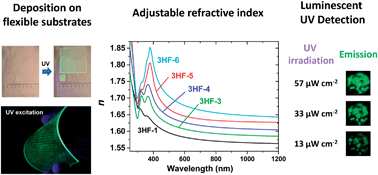F.J. Aparicio, M. Alcaire, A. Borrás, J.C. González, F. López-Arbeloa, I. Blaszczyk-Lezak, A.R. González-Elipe, A. Barranco
Journal of Materials Chemistry C, 2 (2014) 6561
doi: 10.1039/C4TC00294F

Luminescent organic-thin-films transparent in the visible region have been synthesized by a plasma assisted vacuum deposition method. The films have been developed for their implementation in photonic devices and for UV detection. They consist of a plasma polymeric matrix that incorporates 3-hydroxyflavone molecules characterized by absorption of UV radiation and emission of green light. The present work studies in detail the properties and synthesis of this kind of transparent and luminescent material. The samples were characterized by X-ray photoemission (XPS), infrared (FT-IR) and secondary ion mass (ToF-SIMS) spectroscopies; and their optical properties were analysed by UV-Vis absorption, fluorescence and ellipsometry (VASE) spectroscopies. The key factors controlling the optical and luminescent properties of the films are also discussed. Indeed, our experimental results show how the optical properties of the films can be adjusted for their integration in photonic devices. Moreover, time resolved and steady state fluorescence analyses, including quantum yield determination, indicate that the fluorescence efficiency is a function of the deposition parameters. An outstanding property of these materials is that, even for high UV absorption values (i.e. large layer thickness and/or dye concentration), the emitted light is not reabsorbed by the film. Such highly UV absorbent and green emitting films can be used as UV photodetectors with a detection threshold smaller than 10 μW cm−2, a value similar to the limit of some commercial UV photodetectors. Based on these properties, the use of the films as visual tags for the detection of solar UV irradiation is proposed.

